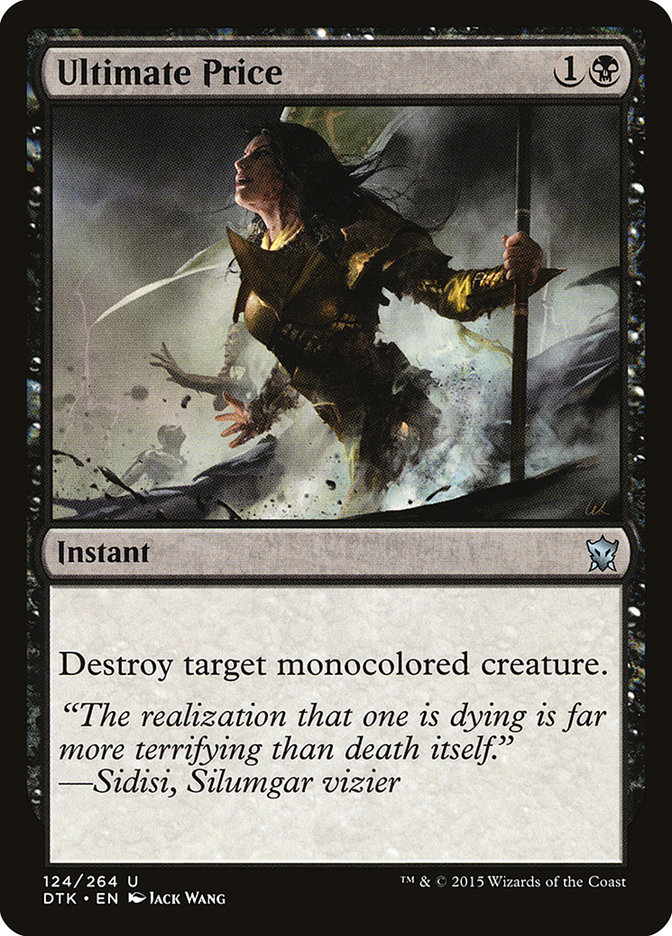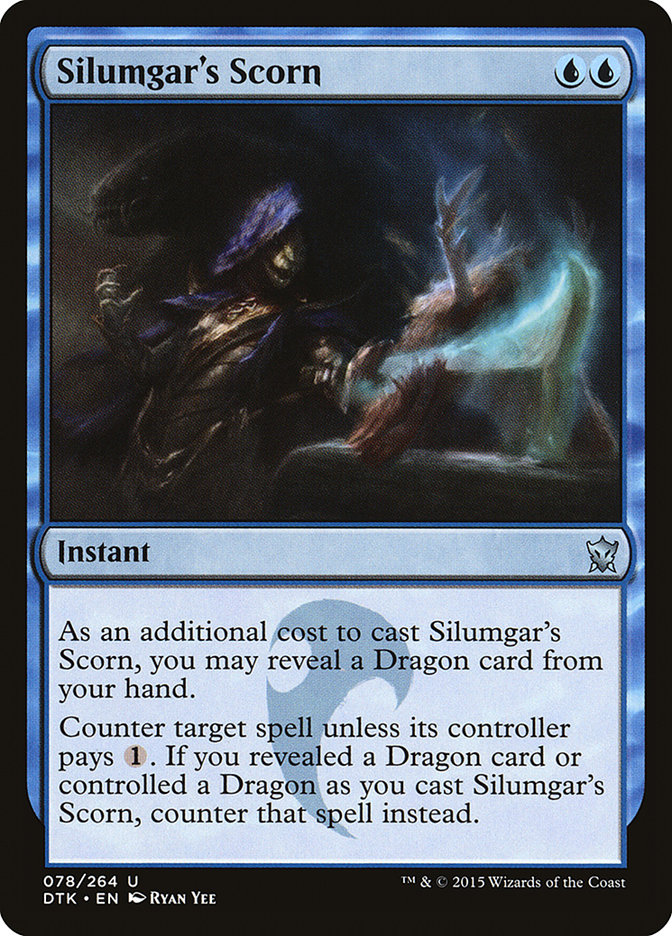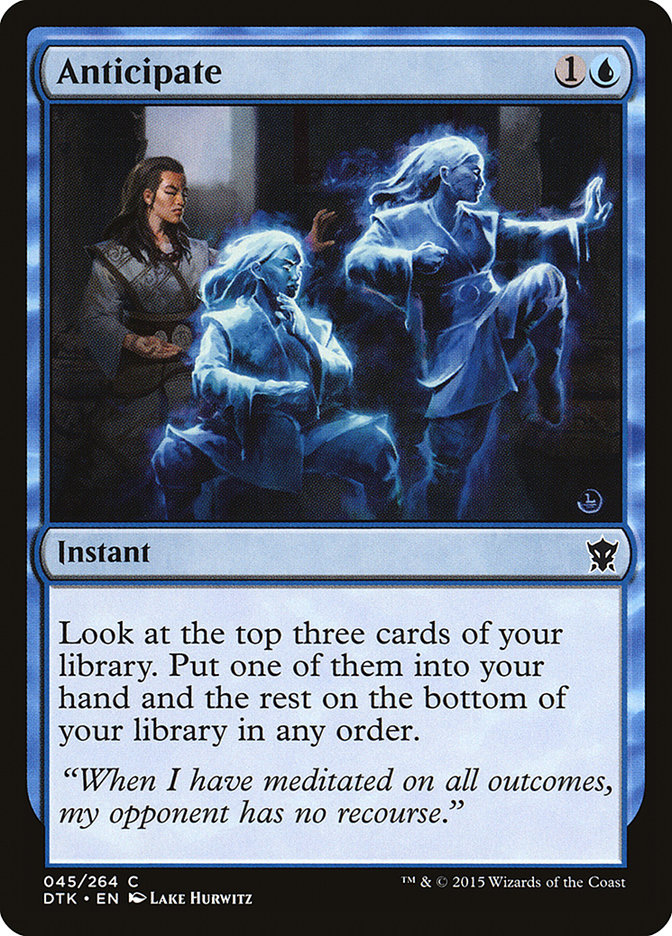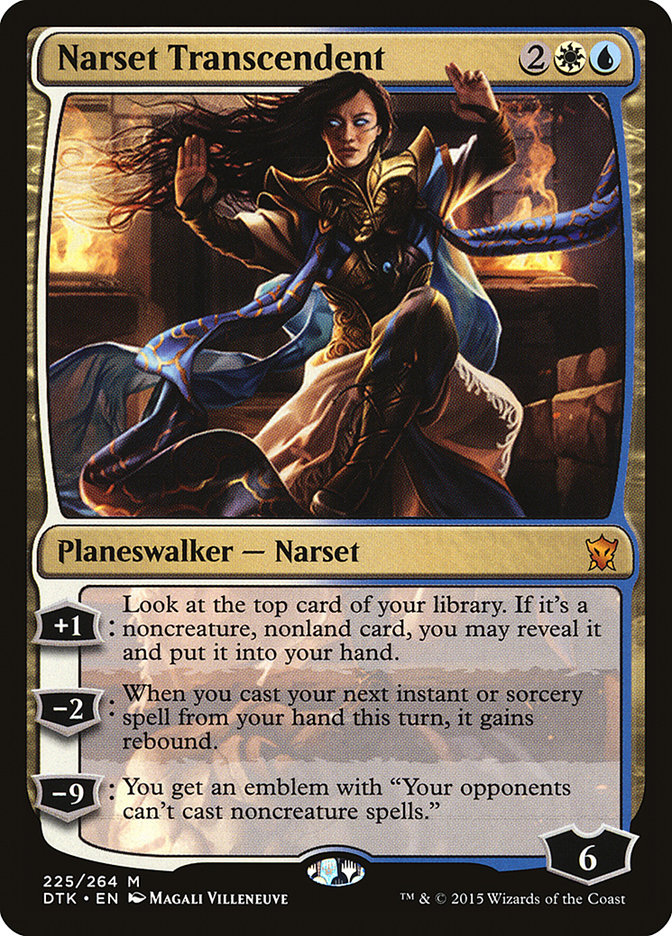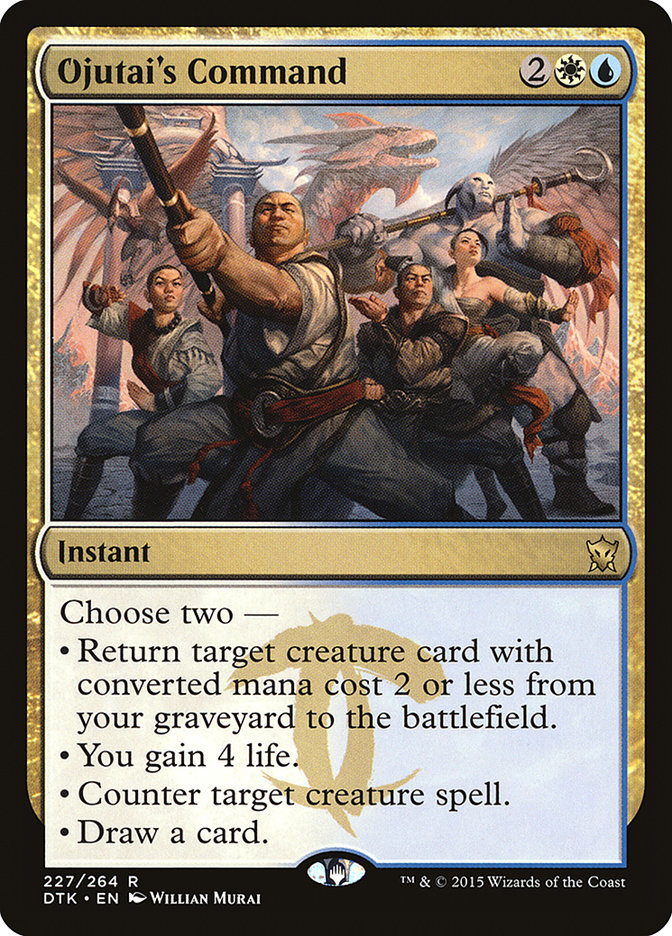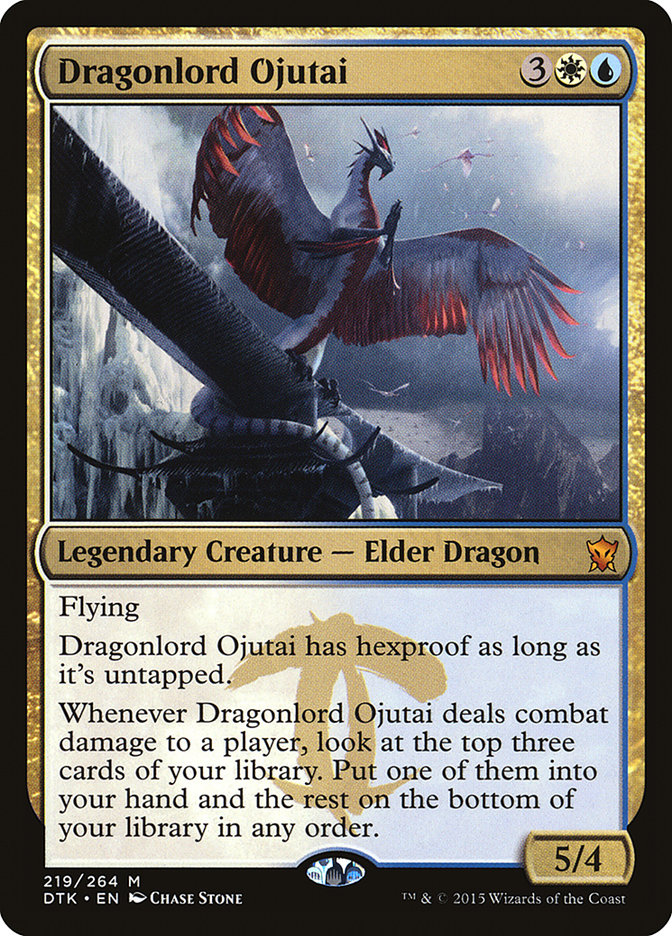I never get hyped for new sets. When the Azorius guild was announced in Return to Ravnica, I had dreams of control dominance, but I never made post after
post praising spoiled cards. There are factors in place that make Dragons of Tarkir a much different story. When control is decent and victory after
victory is achieved, I am less excited about new cards and rotations for obvious reasons. But control is at an all-time low if you are measuring it by the
power level of the spells in Standard today. Dig Through Time is an absurdly powerful spell, but when the next best spell is Dissolve, we have a problem.
Thoughtseize has been the support beam keeping my control dreams in place; however, the poor excuse for removal and sweepers has really backed us into a
corner. Bile Blight is just too hard to cast when trying to Dissolve the next turn regularly. We have to play an equal part black to blue land ratio when
trying to juggle the two extremes. That has always been a struggle for me when developing manabases, which leads me to the advantages of the new set.
Better removal, additional win conditions, fantastic card draw, and a superior counterspell are all about to enter our lives, and it couldn’t have come at
a better time.
The results of Grand Prix Miami really scared me when gauging the longevity of control in Standard. I know things have gotten bad, but not at the extent
that the GP has shown us. Magic Online instantly responded with a vast increase in knucklehead red decks, G/W Devotion, and G/R Aggro. The top 8 consisted
on entirely aggressive decks and even the top 16 was grim for the home team. The question remains, will the new set help the format adjust to a healthier
mix? I believe the answer is yes. I know many of you think that I’d always lean on the side that believes a control renaissance is upon us, but if you look
through my writing from the days of Caw-Blade and Faeries, you’ll see that even I have lost hope at times. But Dragon of Tarkir has too many fantastic
cards that could see play in control decks to be unhappy, and today I’ll be pointing out some of my favorites.
First things first. An Esper decklist, of course:
Creatures (3)
Planeswalkers (4)
Lands (25)
Spells (27)

This is the second coming of Doom Blade for control decks and my favorite card in the set. I mentioned the difficulty and general ineffectiveness of trying
to pack a full complement of Bile Blights in a control deck these days, and Ultimate Price gives us a better option. There are always occasions in Magic
where one card is better than another, but Ultimate Price will be much better than Bile Blight often enough to kick the less effective one to the curb. I
thought I’d add Bile Blight to the sideboard, but Drown in Sorrow does a much better job cleaning up the mess than its two mana brethren.
Ultimate Price finds itself in the same situation as Nullify has for me in the current Standard. It is the perfect spell to burn early, and when drawn late
it still retains its effectiveness. Ultimate Price passes the test of killing a Goblin Rabblemaster early and later sending a Stormbreath Dragon to the
afterlife. There hasn’t been a cheap removal spell that has accomplished this task in quite some time, and I began to wonder if WOTC planned on making that
concession again. In the past, they mentioned more expensive but more powerful removal spells. They gave that same spiel about sweepers and promised
“upside” with the heftier cost. At this point, we have a two mana spell that takes care of a variety of threats and will only hurt you against Abzan Aggro,
which thankfully isn’t too tough of a matchup as is. There will never be a two mana “kill target creature”, so before anyone with pitchforks takes the
social media streets screaming of the weaknesses that Ultimate Price or future control inclusions have, think about that.
When building a powerful control deck, you have to ensure that the drawbacks of your earlier spells are bailed out by the spells that immediately follow.
Threats that Ultimate Price misses will be removed by Hero’s Downfall, your opponent playing around Silumgar’s Scorn will get caught by a Dissolve, or a
board that becomes too tough for Dragonlord Ojutai can be cleaned up by Crux of Fate. These are current examples, but control player’s Magic has followed
this formula for quite some time. Back in the day we could just tap two blue and Counterspell. We live in a dangerous world now and when tossed a card like
Ultimate Price, I bow graciously to the development genies and sleeve it up. There will be some of you that want to play a different amount and still use
Bile Blight and that’s fine. Personally, I’m going to give the immediate need for BB a rest and hope to avoid Fleecemane Lions as much as possible.
If Force Spike was legal, I’d probably give it a shot. There has always been a lot of taboo on cards like Miscalculation and Force Spike, but when that
number goes to three, it becomes broken to a few folks out there. These types of counterspells are at their peak efficiency when the surprise factor
exists, which gives us the advantage early in the new Standard season. We all know the card is being printed, our aggro colleagues know the card is being
printed, but it’s not the same as having the in-game awareness that many pros out there use to gauge skill. What is the worst case scenario even if our
opponent knows we have a Silumgar’s Scorn without a dragon? Are they not going to play their Rabblemaster on turn 3 or wait a little longer? If they begin
to go that route, then we have already won. Three mana is where control players in the current Standard thrive, and that’s what turn we practically win on
if the board is still clean. Silumgar’s Scorn guarantees that clean boardstate on turn 3 when you’re on the play and many times on the draw. Not every deck
out there has a devastating two-drop, but spiking a Voyaging Satyr to the graveyard then untapping with Dissolve is a very good feeling. Ultimate Price is
best friends with Silumgar’s Scorn because of its ability to answer cards that may have slipped through the cracks on the draw. These are all in defense of
it being a Force Spike, but when it is a hard counterspell then our opponents will tremble in fear. This card already has a lot of hype and that hurts us
slightly, but even the threat of a Silumgar’s Scorn or End Hostilities is a powerful tool that can be used for victory. In the control mirror this card
gets a little worse, due to the vast resources that can be built up. For this reason I think that an additional dragon or two need to be played in the
sideboard to give Silumgar’s Scorn teeth later in the game. This card can always be sideboarded out if you feel that the effectiveness decreases in
sideboarded games, but I’m not going to jump to that conclusion anytime soon.
Nullify is sadly replaced by this card. I still think Nullify is fantastic and one of the best two-mana cards for control in Standard, but only one set can
play on the squad. Four Silumgar’s Scorn leaves zero room for Nullify, and four copies of Ultimate Price leaves zero room for Thoughtseize. You know times
have changed and the new cards are powerful when I’m booting out my favorite cheap sorcery; however, these are the times we live in. Instead of taking a
random mana producer/big threat, a counterspell/card draw spell, or a dangerous early card, I’ve elected to have the answers equipped prior to playing a
proactive win condition. This deck wants to Ultimate Price or Silumgar’s Scorn into an Ashiok, Nightmare Weaver, use those prior spells and three mana
veterans to clear the path for a Narset Transcendent, or follow the same logic into one of the dragons we are packing. The control deck flows the same, but
it has the consistency that Esper has lacked for quite some time.
If I hear that Anticipate isn’t Impulse or Telling Time again, I may scream. We know that it’s weaker, but thank the heavens it’s not Divination for the
30th time. This spell is automatically an addition to any control deck you are playing for a variety of reasons. The biggest perk of a two-mana draw spell
is the ability to continue to hit land drops for a control deck. For this reason I’ve dropped my land count to 26, and with the addition of the Temples, I
believe we can get land after land with ease. If you don’t need land, then it fetches up any removal spell, an early planeswalker, or a specific answer you
may need while getting the graveyard a little more thick for delving purposes. One of the biggest problems with playing Esper is hitting the specific
colors necessary to carry out the master plan. With Anticipate, that problem is alleviated some, and you may notice that this Esper build has only four
white cards in the maindeck anyway. I’ve decided to take a different take on Esper and moved into the tri-color strategy because of the weaknesses of
enchantments from U/B Control and the sluggishness early on from U/W Control. Later in the game it serves as a mini Dig Through Time for a win condition or
powerful lategame spell. It does everything that a cheap card draw spell needs to do, and for that reason, it must be played. I am using three of them at
the moment to give it a test run, but I can easily see a fourth one being added. There are times where you do not need to Ultimate Price or Silumgar’s
Scorn an opponent’s play, and having Anticipate in those situations is fantastic.
These are the final cards added to this take on Esper Control. The white splash is primarily for Utter End, but Narset Transcendent is just too sweet to
pass up on. She charges onto the battlefield and immediately goes to seven loyalty, which is absurdly hard to deal with when not playing Hero’s Downfall.
The card advantage, ability to rebound removal/card draw, and a fantastic ultimate are all reasons why the planeswalker will see play for a very long time.
I thought about using Sorin, Solemn Visitor as a complement to the new planeswalker champion, but he pales in comparison on almost all levels. Without
Elspeth, Sun’s Champion, Sorin, Solemn Visitor lacks that gusto that control needs early in the game from a planeswalker. The other white spells from the
new set that are being splashed are Dragonlord Ojutai and the corresponding Command. The Command is a great sideboard card and will be used to gain four
life and draw a card the majority of the time. If you get into a rumble with Abzan and counter a Siege Rhino while adding card advantage, you are going to
come out ahead. I like any card with a lot of versatility, but at this point I have to steer clear of Silumgar’s Command. I don’t think it’s bad; however,
I believe that it should be reserved for U/B Control decks with no splash. Utter End serves the same purpose as Silumgar’s Command, which gives us that
answer to a problematic permanent.
Dragonlord Ojutai isn’t as good as Silumgar, the Drifting Death. If these dragons weren’t legends, then I’d play four copies of the U/B one and call it a
day. Dragonlord Ojutai is a safe tap-out win condition, which is strong in an aggressive Standard format. Once you untap and can protect it, Dragonlord
Ojutai will produce significant card advantage on it’s own. I like Prognostic Sphinx too much to cut it completely, but you’ll notice a second copy of
Dragonlord Ojutai in the sideboard to strengthen our two-mana counterspell. The fact that it can’t be Ultimate Priced is another hexproof-like benefit in
the control mirror. I don’t mind our win conditions having a Hero’s Downfall or Utter End, because with card draw and protection, we can still win with
what’s left. Dragonlord Ojutai is going to need a little live play before I can give the verdict on power level, but either way, the spot with the drifting
dragon has been earned.
The Haven of the Spirit Dragon is a toss in one-of simply to resurrect a fallen hero. It helps cast our white splash and is a decent draw later in the
game, so I’m giving it a shot over a random Radiant Fountain that I was going to play. There are a lot of people who won’t play less than three or four
Radiant Fountains, and that is fine in the two-color decks. When playing three color, we have tough cuts to make and a lot of enters the battlefield tapped
lands that are necessary. In return for those drawbacks, we get power, and I hope that this version of Esper Control helps you all in the early stages of
this Standard.
I’m not back on Esper Control just to be back on something familiar, but I truly feel that U/W and U/B Control are lacking just a little bit of earlygame
consistent answers to this new aggressive era. Only a third color can fix that. This will be the list I start with when preparing for the Season One
Invitational in Richmond at the end of the month, so keep an eye out on Twitter for changes from testing.


